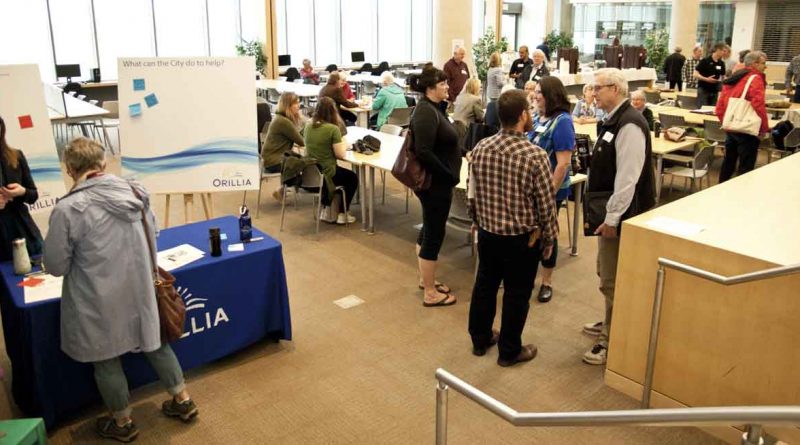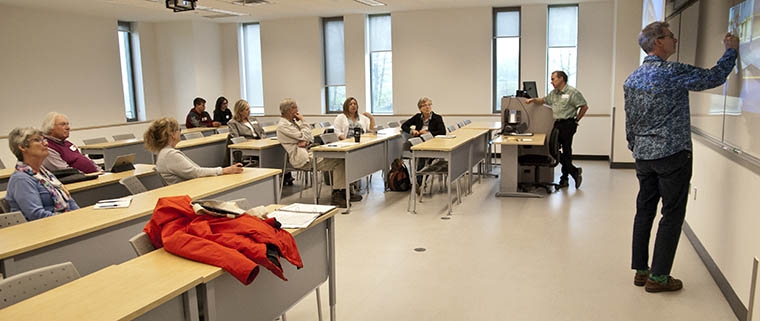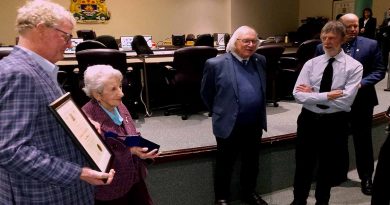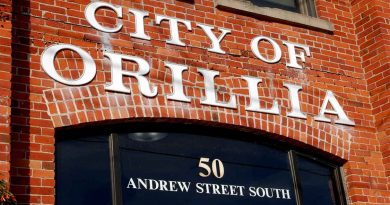Sustainable Orillia Out Of The Gate
By John Swartz
Sustainable Orillia’s move into the public realm last weekend was a success. The opening night at the Orillia Community Church where 130 people watched the documentary Anthropocne: The Human Epoch bode well for Saturday’s day-long program at Lakehead University. Fred Larsen, SO’s treasurer, estimated there were 115 people attending the idea generating exercise.
The documentary had stunning visual effect. Many times new subjects were introduced in close up before revealing things like, strip mines, hundreds of acres of garbage and other not so good things about what people have done to the environment and councillor Dave Campbell, who was present both days, said he was too afraid to find out what the beautiful looking images would reveal.
The filmmakers relied on long sequences of visual images to make impressions rather than countless words spoken in narration, a more effective method of storytelling than is usually the case. Many of the audience would return Saturday and seeing the documentary provided context for those sessions.
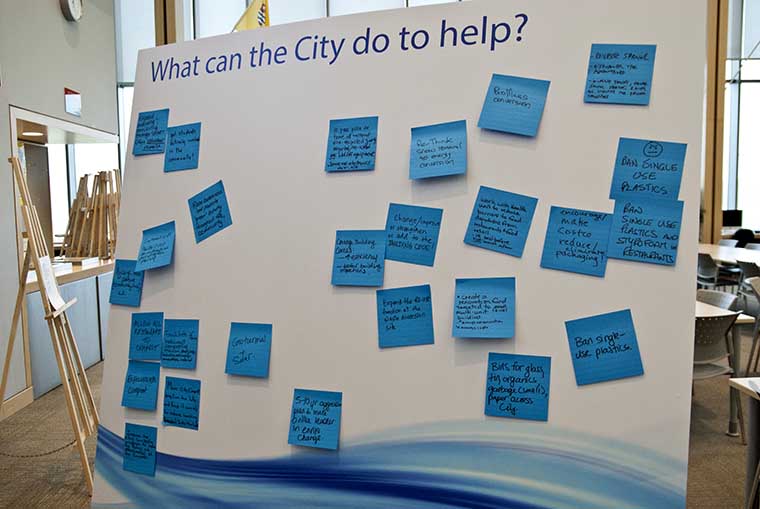
Saturday opened with a smudge ceremony by Elder Trish Monague. SO chair, Stan Mathewson’s introduction included the Native axiom actions and decisions “must consider the impact on the 7th generation” to follow. This brings to mind the thought, where would we be today had Western society operated with that in mind? Quite possibly not attending a function like the SO launch.
Mathewson observed it is no longer possible to separate the economy from the environment. Many industries have been affected by the severity of storms and rising sea levels climate change is causing. He told attendees there are things we can do locally that can positively affect our way of life – not all of them have to do with combating the source of climate change – green house gasses – and “today we roll up our sleeves and get into it.”
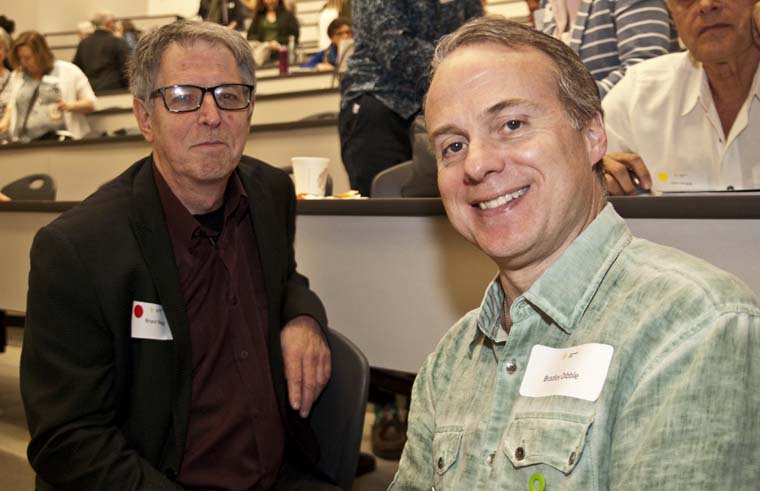
Dr. Brad Dibble, a Barrie cardiologist and author, addressed the audience the data and evidence is in but the way out is multi-facetted. Interestingly, it was a series of small measures and actions which created present circumstances and his message was, even though the problem seems insurmountable and huge, small measures taken on a local or even individual level can make a difference.
He closed with a message for people who don’t believe there is a problem with a cartoon with text reading – what if this is all a big hoax and we create a better world for nothing?
Bruce Nagy, author of The Clean Energy Age, said those who talk about a coming crisis don’t really understand “we’re in a crisis now.” He said there are only up sides to moving (faster) toward clean energy generation, it only pays for itself. Of course there’s an initial cost, but when one thinks about lower monthly bills, plus the savings society will have not having to pay for sun spills, solar panel explosions, and increased medical bills due to fresh air, it’s a wonder we’ve been so oblivious for so long.

After lunch, but before heading off to one of the nine sector sessions, we were shown the short video of a speech 12-year-old Zoe Roe wrote for a school project. It was taped by Tyler Knight at his Refillery District, and the subject matter was about plastic being in places it shouldn’t be. The Friday night audience saw it too. Zoe did an impressive job piecing together the problem and concern of her generation. Speaking with her grandfather, Mike Shillolo, who is on the SO organizing committee, he revealed she wasn’t using cue cards as one might have thought based on her frequent glances off-camera. He said it was shot in one go and she was nervous and kept glancing at the people off camera who were present at the shoot. Knowing that puts her speech in an entirely different light.
The rest of the afternoon was spent in small groups. The project is broken down into manageable bites according to the subjects previously outlined in SUNonline/Orillia here.
Without time to spend extensively in each group, what was impressive was how each was evenly populated, one or two weren’t hogging all the attendees.
In the transportation and energy group, which Mathewson and Tony Telford were leading (Bruce Nagy sat in), one idea, to promote electric vehicles more vigorously turned out to have an issue to be solved first. You can’t have hundreds or thousands of cars plugged in to recharge all at once with our present electrical grid. Demand would surpass supply, so more work needs to be done storing power in batteries during off-peak times to meet the demand.
This is one of the qualities of the choice to have knowledgeable people chair each sector, lots of people have good ideas, but there some work with infrastructure to come first.
In the arts and culture session, lots of ideas were generated to promote green art materials (paints, papers, etc.) and some of the discussion was about how to get the many and isolated artists and groups of artists connected to what may become Sustainable Orillia programs.
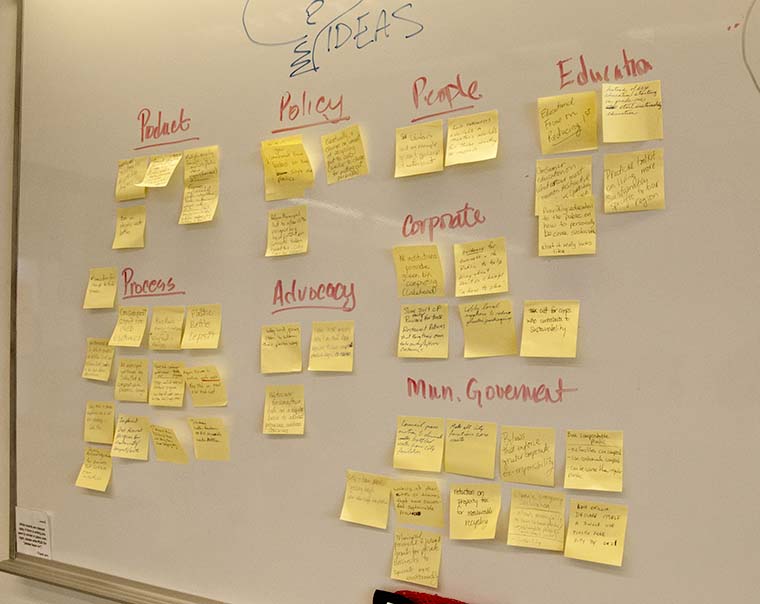
Mathewson said he was impressed with the mood everyone had returning to the lecture hall at the end of the day to recap. He felt most were genuinely excited they could be part of doing something positive and he was also surprised with how several suggestions and ideas fit into more than one sector, which committee chairs will next work on assimilating into a report to the community.
Sustainable Orillia has a website where those who wanted to go, but couldn’t, or those who are thinking it’s time to get on the band wagon can find out how to be part of the solution.
(Photos by Swartz – SUNonline/Orillia)

